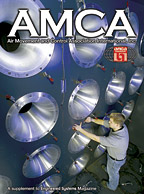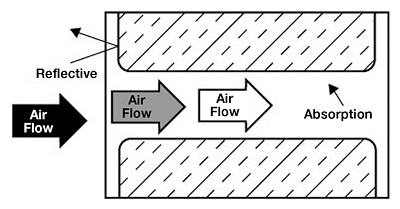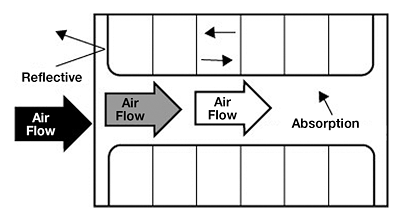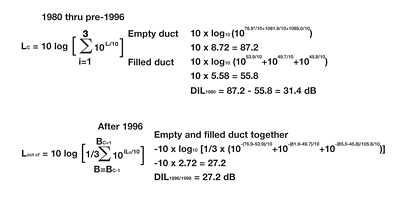

How Can You Measure Performance?
In laboratory conditions it is much easier to measure performance than in field conditions. In fact, it is almost impossible to duplicate laboratory performance in the field due to outside noise sources or break-in noise. There are two parts to measuring sound performance, laboratory accuracy and calculation of data. Laboratory accuracy due to equipment calibration and verification of procedures is critical to the consistency of the data produced. Just as critical are the calculation methods used to analyze the data. A NVLAP- (National Voluntary Laboratory Accreditation Program) accredited laboratory meets the requirements of the first part, because a NVLAP laboratory is based on following procedures of not only how to keep the equipment calibrated, but also keeping consistency and accuracy in the test reports.The second part is following the latest version of ASTM E477. This is particularly important since the calculation methods have changed over the years. E477 is the standard test method for measuring acoustical and airflow performance of duct liner materials and prefabricated silencers.
The first ASTM standard was written in 1973 (E477-73). Between 1973 and 1995 reverberation room requirements were solely based on the methods of ASTM standard E90, which is used to determine transmission loss of acoustical barriers. In the pre-1996 versions of the E477 standard, the test duct requirements were vague regarding allowable construction, "... duct system should be of adequate mass." The problem with this is that lighter ductwork allows more sound waves to "break out" of the test duct and therefore gives the appearance of higher insertion loss values for the silencer.
Today's standard requires a minimum of 14-gauge material to construct the test duct and it states that damping material may be necessary when testing high insertion loss units to reduce environmental and/or flanking noise. All of these variables affect how the physical sound is measured.
Flowmeter requirements were also not clearly defined as to their location in relation to the test sample. Meters could be strategically located to take advantage of the natural flow patterns within the duct, again providing inaccurate airflow data. In 1996, ANSI 12.31 or ISO3741 test method procedures were added as a requirement if flow-generated noise was to be measured in the room. Flowmeter stations now have a minimum separation of 2? duct diameters upstream and 5 duct diameters downstream from the test sample.

How Do You Know The Performance Is To The Latest Standard?
The manufacturer's literature should state what version the performance is based on. If the literature does not state the latest version, you should request a test report based on the latest version. Prior to 1996, calculations were likely to show a higher dB reduction in certain bands even when utilizing the same raw data each formula. Some manufacturers have not updated their literature used for product selection and currently show their performance based on an outdated version of E477.What has changed in each version is primarily the calculation method of DIL. The methods have become more accurate, which does not necessarily reflect better performance. Calculating the insertion loss by using the same raw data from a sample silencer against E477-80 and then against E477-99 will produce performance with a DIL variance of as much as 4dB. An earlier version E477-73 could produce a variance of as much as 7dB. Simply stated, pre-1996 versions of ASTM E477 can significantly overstate DIL. Table 1 better illustrates the difference in the calculation method.
The difficulty for the engineer is that it is impossible to compare product performance using different methods of calculation. Once the unit is in the field, it will be even more difficult to verify if the manufacturer meets their own published performance. Therefore, it is paramount for engineers to specify the latest version of E477, which today is E477-99.
How Does AMCA Compare To NVLAP?
It's simple, AMCA covers all the bases. AMCA (Air Moving and Control Association) has developed a certified rating program (CRP) for prefabricated acoustical duct silencers. Publication 1011-03 details the test method and procedure for licensing a product. Products meeting the requirements of the CRP are licensed to carry the AMCA seal.The AMCA seal will give you the same assurance for the silencer performance as it does for fans, dampers, and louvers. Most importantly, AMCA reviews performance data provided in the manufacturer's literature and conducts verifications tests on silencer samples to confirm that published data reflects the actual performance. The performance rating includes the acoustical dynamic insertion loss, airflow generated noise and pressure drop as a function of airflow obtained in accordance with ASTM E477-99.
A NVLAP-accredited laboratory by itself does not certify literature and does not perform check tests. In the industry there are half a dozen or so NVLAP-accredited laboratories, and some will soon become AMCA registered. Once a lab is registered by AMCA, the data produced is in accordance with E477-99 or the latest version.

Conclusion
Silencer performance is critically important to the successful commissioning of each project. Unfortunately, because not all manufacturers maintain their published performance data in accordance with the most current version of ASTM E477, the often extensive silencer performance data review task is made even more complicated. The specifying engineer is left to decipher changes in the test standards and pore over numerous detailed test reports in order to be certain that product performance is accurate and sufficient to meet the specified requirements. Fortunately, the process is now much easier and very reliable. Simply specifying silencers licensed in accordance with the AMCA 1011 Certified Ratings Program will eliminate all the guesswork and ensure comparable data because AMCA 1011 mandates and ensures that:
- All tests are conducted in strict accordance with the latest ASTM E477 test standards;
- All published performance data is independently verified by AMCA staff; and
- Ongoing and periodic check tests are conducted on all products to certify and maintain accuracy both now and in the future.
